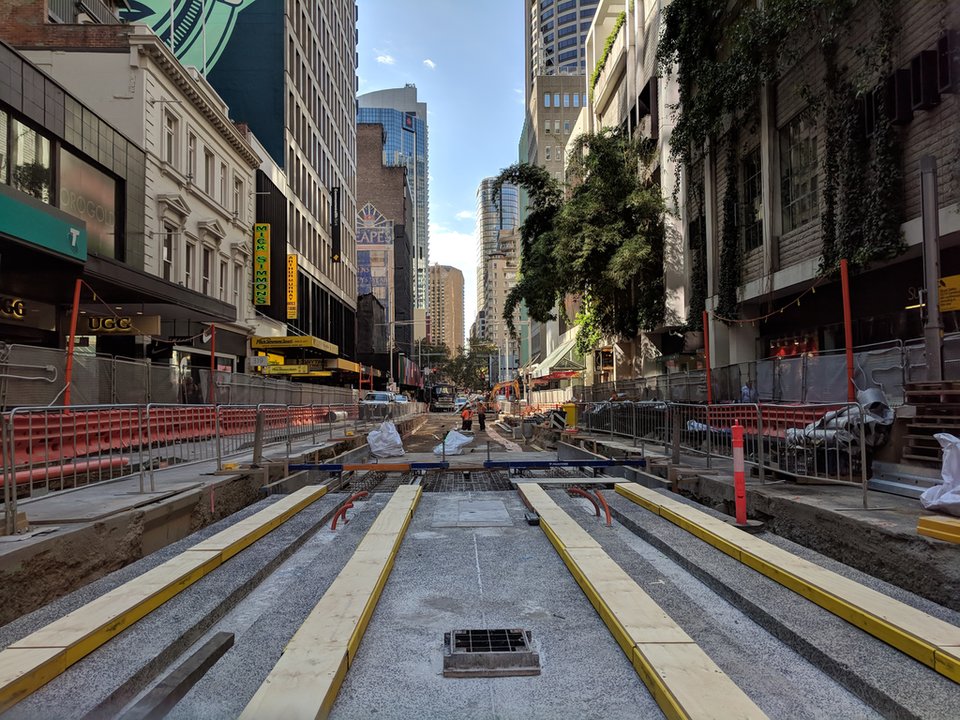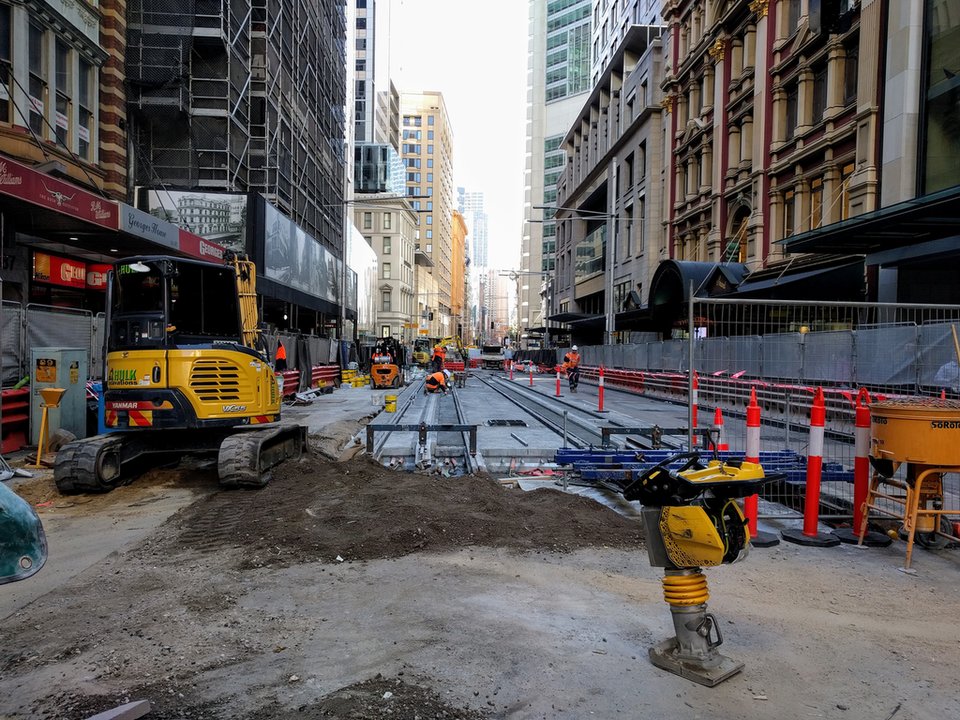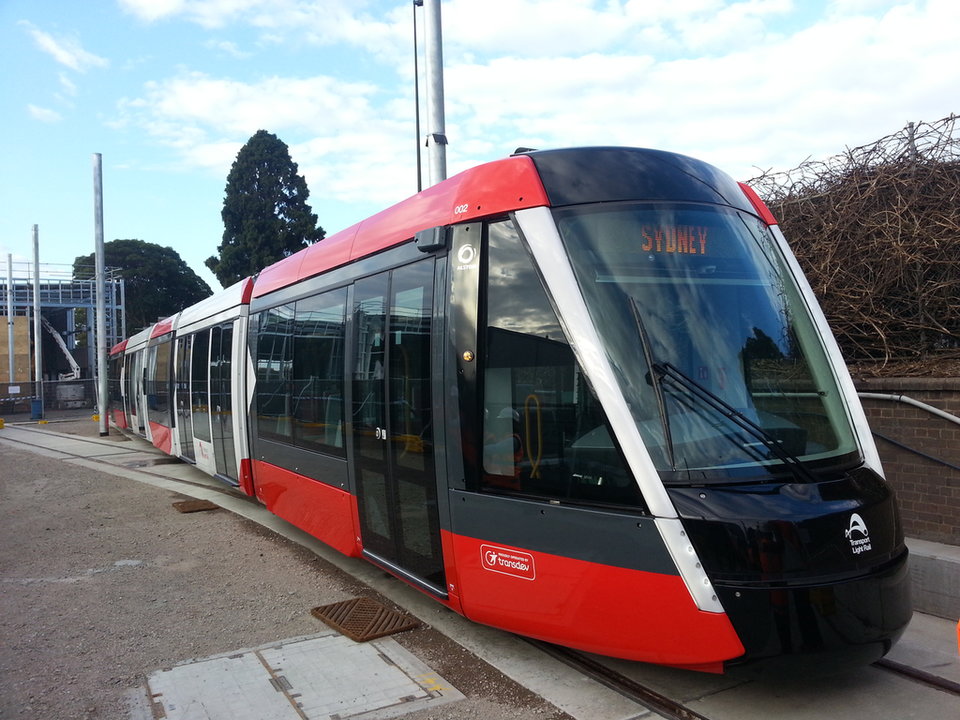The project’s budget has ballooned by A$500m
Sydney’s new light rail:
delays and budget blowouts
In Sydney, the ongoing construction of the CBD and South East Light Rail project, which will connect the city’s central business district (CBD) with the suburbs of Randwick and Kingsford, is today acting as an unfortunate showcase of the risks of urban light rail development and the paramount importance of rigorous planning.
The CBD and South East Light Rail project was first announced in December 2012, consisting of a 12.5km, 19-stop tram line between Circular Quay and the CBD before splitting into two branches terminating at Randwick and Kingsford. The plan was sold to Sydneysiders as an effective, high-capacity means of cutting traffic congestion on the economically vital George Street, 40% of which will be pedestrianised under the plan. The then-Transport Minister for New South Wales (NSW) Gladys Berejiklian, who became the state’s Premier in 2017, warned at the time that traffic congestion in the CBD would “only get worse” without quick action.
“With the introduction of light rail and the redesigned bus network announced today, we will be able to significantly reduce the number of buses clogging the city’s streets and provide fast and reliable links for people to key destinations like the Prince of Wales Hospital, University of NSW, SCG, Allianz Stadium, Moore Park, Central and Circular Quay,” Berejiklian said in 2012.
Fast-forward to today and the project is beset with issues. The original completion date for the project was set at March 2019, but a host of technical and legal issues has seen this date pushed back by a year to March 2020. Berejiklian said in August that the government is working “pedal to the metal” to bring the deadline forward to December 2019, while statements made by the project’s Spanish subcontractor Acciona – part of the ALTRAC Light Rail Partnership responsible for the project – put the completion date even further out, at May 2020.
The project’s budget has also ballooned by A$500m, from A$1.6bn at its outset to an estimated A$2.1bn today. The cost increase has prompted the NSW Government to provide a guarantee for $500m in private sector loans. Last month, Reserve Bank of Australia governor Philip Lowe highlighted the project as an example of inadequate oversight of infrastructure projects.
“I live in Randwick, so I am living with that [substandard governance] continuously with the tram,” Lowe said.

Credit: Peter Selway / Schneider Electric
What lies beneath?
The delays and budget overruns are politically costly for Berejiklian, who would have hoped that the project finishing on time, just before the NSW state elections in March 2019, would act as a showcase for the progress made by her government. Instead, she and the Liberal Party that she leads in NSW will have to make their pitch to the state’s voters with the light rail project hanging like a millstone around their necks. So how has the project become a byword for poor infrastructure planning and what are the root causes?
The foremost technical reason for the delays has been a dispute over the treatment of underground electrical infrastructure along the line’s route. State transit authority Transport for New South Wales reportedly prevented Acciona from directly dealing with public electrical infrastructure firm Ausgrid, back when the deal with Acciona and ALTRAC was being finalised in early 2015. According to Acciona, Transport for NSW had provided assurances that Ausgrid had agreed to a plan on how to treat its sub-street infrastructure.
But once the deal for the project was closed in February 2015, Acciona says it received a set of completely different and more stringent requirements from Ausgrid, including extensive work on 106 utility pits, extra relocations of services and adding spare conduits. If it had known of this extra work, Acciona says it would not have pursued the contract under the given terms.

“Acciona would not have executed the [design and construct] contract because to do so in those circumstances was to expose Acciona to significant risk,” the company argued in a court document reported by the ABC.
“Every time the contractor digs a hole there is something underneath the ground that they weren't told about,” deputy NSW Labor party leader and opposition spokesman Michael Daley told the ABC in April. “That's because [Berejiklian] rushed this project … it should have taken two years to plan.”
With Acciona facing hefty fines to compensate for work delays on the project, the company foiled Supreme Court proceedings against the NSW Government in April, seeking A$1.2bn in extra payments because of the Government’s alleged misleading representations. The NSW Government is defending itself vigorously, with Transport Minister Andrew Constance accusing the contractor of using ‘go-slow’ tactics on the project and arguing that the company must be held to its contractual obligations.

The foremost reason for the delays has been a dispute over underground electrical infrastructure along the route
Significant doubts have been raised concerning the commercial viability of the service
Doubts over cost-effectiveness
It’s not only technical flaws and contractual disputes that have seen the CBD and South East Light Rail branded a lame duck. Even once the project manages to limp over the finish line, significant doubts have been raised concerning the commercial viability of the service.
In September, controversy over the project deepened when leaked documents suggested that the NSW Government was informed of the light rail line’s shaky economic foundations back at the very outset of its planning stages in 2012. A confidential appraisal prepared for the Government in 2012, seen by the ABC and Fairfax Media, analysed the cost-benefit ratios of more than two dozen modelled light rail lines around the Sydney CBD and found that none of them would provide benefits to taxpayers equalling the project’s cost, which was estimated at just A$1.1bn at the time.
The Circular Quay to Randwick route – which is being used for the line currently under construction – was the best-performing of the bunch, but the report still noted that it would likely only return 80 cents in economic benefits for every dollar spent. Perhaps more worryingly, the appraisal also flagged that none of the lines would make a significant impact on travel times or congestion in the area, and that sub-street utility infrastructure was a major risk that had already thrown a similar light rail project in Edinburgh, Scotland into disarray.

A new appraisal was prepared for NSW in 2013, shifting the cost-benefit ratio to positive after incorporating ‘non-conventional’ economic benefits such as A$160m from pedestrianising a stretch of George Street and A$50m in ‘non-use values’, which monetises the value ascribed to a project by those who don’t use it.
Australian National University economist Professor Leo Dobes told the ABC that the inclusion of non-use values in the cost-benefit analysis was “very, very dicey stuff”, and the revelations have further exposed Berejiklian’s government to allegations that it rushed the project and rigged the planning system in its favour. Constance has defended the process, arguing that earlier cost-benefit studies couldn’t factor in upgrades such as a new metro station next to the light rail line.
“We are going to continue to see unexpected benefits as a result of light rail,” Constance told the ABC’s 7.30 programme in September.
In spite of the fiasco surrounding the CBD and South East Light Rail, the NSW Government has further light rail plans in mind for the city under the sunny banner of ‘Sydney’s Light Rail Future’, including planned extensions of existing lines and a proposed new light rail service connecting the suburb of Parramatta.
Given the intense criticism the government has attracted over the current project, there will be hard lessons for policymakers and city authorities to take into these future endeavours, if Sydneysiders haven’t been put off the idea of light rail entirely. If nothing else, the prime importance of an unhurried, comprehensive planning phase should be at the front of their minds, along with these possibly apocryphal words of wisdom, often attributed to President Abraham Lincoln, on the value of preparation: “Give me six hours to chop down a tree and I will spend the first four sharpening the axe.”

